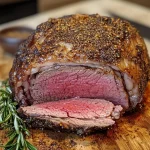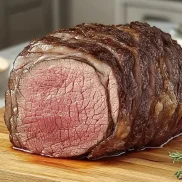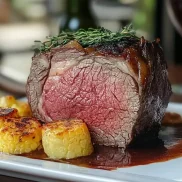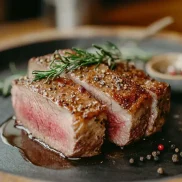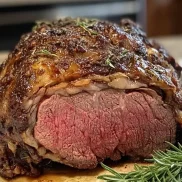What is the best way to season a prime rib? When it comes to culinary excellence, few dishes captivate the imagination like a perfectly seasoned prime rib. This exquisite cut of beef, often reserved for special occasions and celebrations, represents the pinnacle of flavor and tenderness. But what exactly makes this dish so remarkable, and how can you ensure that your prime rib is the star of the table? Understanding the fundamentals of prime rib is the first step in achieving seasoning perfection. For those looking to create an exceptional flavor, consider exploring a well-crafted prime rib roast rub recipe to elevate your dish.
The key to preparing an unforgettable prime rib lies not only in the seasoning but also in selecting the right cut, understanding its unique qualities, and mastering the preparation techniques. Let’s dive into the basics to set you up for success in crafting this show-stopping dish.
Table of Contents
Understanding the Basics of Prime Rib
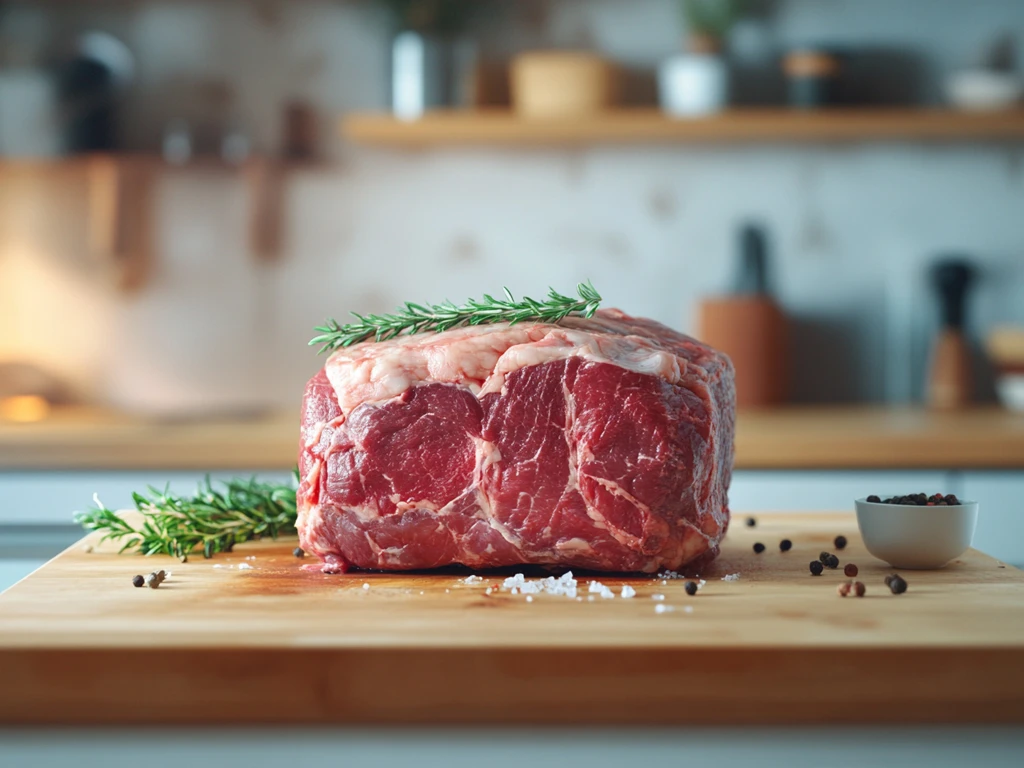
Prime rib, often referred to as a standing rib roast, is a premium cut of beef known for its marbling, tenderness, and robust flavor. This cut comes from the primal rib section of the cow, which includes some of the most succulent and flavorful portions of beef. Its reputation as a luxurious centerpiece at gatherings is well-deserved, but preparing it correctly requires a bit of know-how.
What Makes Prime Rib Special?
Prime rib stands out because of its perfect balance of marbling and meat. The natural fat content in this cut melts during cooking, infusing the meat with a rich, buttery flavor. Additionally, the tenderness of the prime rib is unparalleled, making it an ideal choice for those who appreciate a melt-in-your-mouth dining experience.
Another factor contributing to its appeal is its versatility. Whether you prefer a simple seasoning of salt and pepper or a more elaborate herb crust, the prime rib’s robust flavor can handle a variety of seasoning profiles. This flexibility allows you to tailor it to suit different palates and occasions.
Cuts of Prime Rib: A Quick Overview
When shopping for prime rib, you’ll encounter different cuts, each with its unique characteristics. The most common options include:
- Bone-In Prime Rib: Known for its rich flavor and visual appeal, this cut includes the rib bones, which can act as a natural roasting rack. The bones also help retain moisture, ensuring a juicy roast.
- Boneless Prime Rib: Easier to carve and slightly more uniform in shape, this option is ideal for those who prefer convenience over tradition.
- First Cut (Loin End): Taken from the loin end of the rib section, this cut is leaner and more tender, making it a favorite for those who prioritize texture.
- Second Cut (Chuck End): With a higher fat content and more marbling, this cut delivers a more robust flavor, perfect for those who enjoy a richer bite.
Choosing the Right Cut for Your Recipe
Selecting the right cut of prime rib depends on your preferences and the occasion. For a classic presentation and maximum flavor, a bone-in prime rib is an excellent choice. The bones not only add a dramatic flair to the dish but also contribute to the cooking process by insulating the meat, resulting in even heat distribution.
If convenience is a priority, the boneless version offers simplicity without sacrificing flavor. When choosing between the first and second cuts, consider your audience. For a leaner, more tender experience, the first cut is ideal. On the other hand, if you’re looking to impress with bold flavors and a luscious texture, the second cut is the way to go.
By understanding these basics, you’re already halfway to creating a seasoned prime rib that’ll leave your guests raving. Next, we’ll explore the art of seasoning and preparation to elevate your prime rib to gourmet heights.
Preparing Your Prime Rib for Seasoning
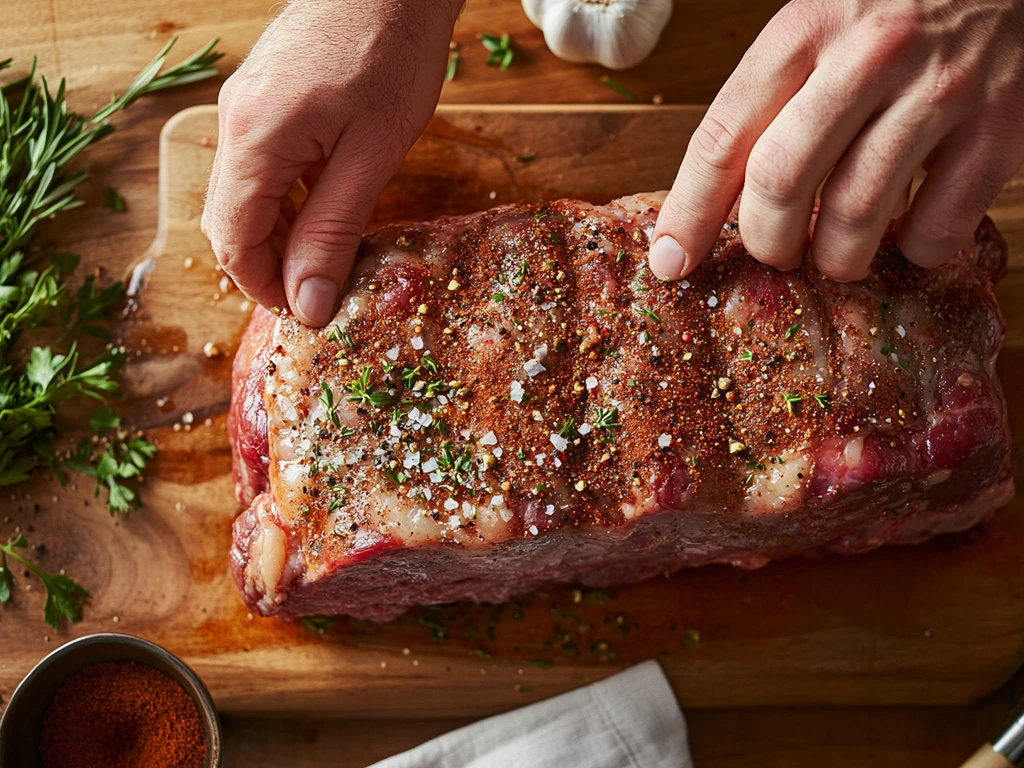
Seasoning a prime rib to perfection begins with proper preparation. Every great recipe starts with the basics, and in the case of prime rib, that means paying attention to details like fat trimming, marinating, and brining techniques. Preparing your prime rib thoughtfully ensures that it absorbs flavors evenly, cooks beautifully, and delights everyone at the table. Let’s explore the key steps you’ll need to follow.
Trimming Excess Fat: To Do or Not to Do
Prime rib is renowned for its marbling, which contributes to its rich flavor and tenderness. However, the exterior fat cap can sometimes be excessive, and deciding whether to trim it is a matter of balance. Here are some points to consider:
- Flavor Retention: Leaving a thin layer of fat enhances the meat’s juiciness and ensures it stays moist during cooking. The fat melts, basting the roast naturally as it cooks.
- Aesthetic Appeal: Removing excess fat can improve the appearance and allow seasonings to penetrate directly into the meat, rather than sitting on the outer layer of fat.
- Compromise: A good rule of thumb is to leave about ¼ inch of fat. This strikes a balance between flavor enhancement and ease of seasoning.
Ultimately, trimming is a personal choice. If your cut has a very thick fat layer, consider trimming it down slightly for optimal results without compromising the meat’s natural richness.
Should You Marinate Prime Rib?
Marinating a prime rib is not essential, but it can elevate the flavor profile if done correctly. Unlike tougher cuts of meat that require marinating for tenderness, prime rib’s appeal lies in its natural succulence. Here are the pros and cons of marinating:
- Pros: A well-balanced marinade can add complementary flavors such as garlic, herbs, and citrus. It’s particularly useful for introducing nuanced notes that meld with the meat’s richness.
- Cons: An overly acidic marinade can compromise the prime rib’s texture, making it mushy rather than tender.
If you choose to marinate, keep it simple. A blend of olive oil, garlic, rosemary, thyme, and a splash of lemon juice works wonders. Limit the marination time to 2–4 hours to avoid overpowering the beef’s natural taste.
Dry Brining vs. Wet Brining: Key Differences
Brining is an excellent technique to enhance flavor and ensure juicy meat, but should you go with a dry or wet brine? Let’s break it down:
Dry Brining
- Method: Coat the prime rib generously with kosher salt and optional spices, then refrigerate uncovered for 12–24 hours.
- Benefits: Dry brining intensifies the beef’s natural flavor by allowing the salt to penetrate deeply. It also dries out the surface, helping to create a beautiful crust during roasting.
- Best For: Those who prefer a simple preparation with maximum flavor impact.
Wet Brining
- Method: Submerge the prime rib in a solution of water, salt, sugar, and optional aromatics (like bay leaves and peppercorns) for 6–12 hours.
- Benefits: Wet brining can add moisture and infuse additional flavors, which is particularly beneficial for those seeking a unique taste profile.
- Best For: Those who want to experiment with creative flavor combinations.
Both methods have their merits, but dry brining is often preferred for prime rib due to its simplicity and effectiveness. Regardless of the approach you choose, brining is a step worth considering to elevate your prime rib’s taste and texture.
With your prime rib properly trimmed, marinated (if desired), or brined, you’re now ready to move on to the seasoning process. These preparation techniques lay the foundation for a roast that’s flavorful, tender, and utterly unforgettable.
Essential Ingredients for Perfect Seasoning
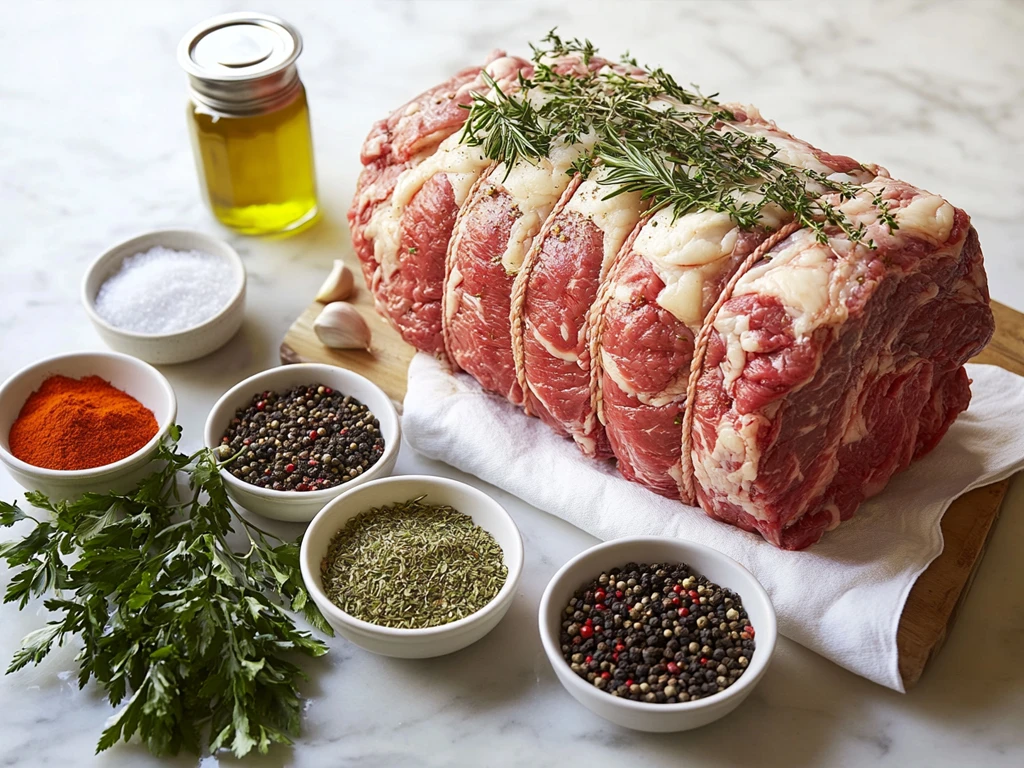
Seasoning a prime rib is an art that relies on choosing the right ingredients to enhance the natural flavors of the beef. The goal is to complement, not overshadow, its rich and savory profile. By understanding the role of foundational ingredients like salt and pepper, aromatic herbs and spices, and robust aromatics, you can craft a seasoning blend that elevates your prime rib to culinary perfection.
The Role of Salt and Pepper
Salt and pepper are the unsung heroes of prime rib seasoning. While they may seem basic, their proper use can make a world of difference. Here’s why:
- Salt: Salt acts as a flavor enhancer, drawing out the natural richness of the beef. It also helps to tenderize the meat by breaking down proteins. For best results, use kosher salt or sea salt, as their larger crystals provide better coverage and penetration.
- Pepper: Freshly cracked black pepper adds a subtle kick and earthy undertones that balance the richness of the meat. Its texture also contributes to forming a flavorful crust during cooking.
Pro Tip: Generously season your prime rib with salt at least 12–24 hours before cooking. This dry brining technique ensures the seasoning penetrates deeply, enhancing every bite. Add the pepper just before roasting to preserve its bold flavor.
Aromatic Herbs and Spices: A Complete Guide
Herbs and spices are the backbone of any seasoning blend, offering layers of complexity and aroma. Here are some popular choices for prime rib:
- Herbs:
- Rosemary: Its piney, slightly minty flavor pairs beautifully with beef.
- Thyme: A versatile herb with earthy and peppery notes.
- Parsley: Adds a touch of freshness and brightens the seasoning.
- Spices:
- Paprika: Whether sweet or smoked, paprika adds depth and a subtle hint of sweetness.
- Cumin: A warm and nutty spice that complements the richness of beef.
- Coriander: Offers a citrusy and slightly sweet flavor.
Pro Tip: Use fresh herbs whenever possible for maximum flavor. Combine them with a touch of olive oil to create a paste that adheres well to the meat.
Using Garlic, Shallots, and Other Aromatics
Aromatics like garlic and shallots are essential for infusing your prime rib with robust, savory flavors. Here’s how to use them effectively:
- Garlic: Fresh garlic cloves can be minced and mixed into a seasoning paste or inserted into small slits cut into the meat. Roasted garlic offers a milder, sweeter flavor that pairs perfectly with herb-crusted prime rib.
- Shallots: These small, sweet onions add a delicate, sophisticated layer of flavor. Sauté them in butter and mix them into your seasoning blend for added richness.
- Other Aromatics: Consider using leeks, celery, or even a touch of citrus zest for a unique twist. These ingredients add subtle complexity without overpowering the beef’s natural taste.
Pro Tip: When using garlic and shallots, balance their intensity with the other ingredients to avoid overpowering the roast. A light touch goes a long way in creating a harmonious flavor profile.
By mastering the use of these essential ingredients, you’ll be well on your way to creating a perfectly seasoned prime rib. The combination of salt, pepper, herbs, spices, and aromatics will bring out the best in this luxurious cut of beef, ensuring a roast that’s both flavorful and memorable.
What Is the Best Way to Season a Prime Rib? Step-by-Step Techniques
The art of seasoning a prime rib involves more than just sprinkling salt and pepper. By using thoughtful techniques such as applying a dry rub, basting, or injecting flavors, and deciding between butter or oil, you can achieve a roast that’s bursting with flavor. Here’s a guide to mastering these methods.
Applying a Dry Rub: How and Why
A dry rub is one of the most effective ways to enhance the flavor of a prime rib. Here’s why it works and how to do it:
- Why Use a Dry Rub?
- A dry rub adds layers of flavor directly to the surface of the meat.
- It helps create a caramelized crust that contrasts beautifully with the tender interior.
- How to Apply:
- Combine your desired spices and herbs in a bowl. A classic mix might include kosher salt, black pepper, garlic powder, paprika, rosemary, and thyme.
- Pat the prime rib dry with paper towels to ensure the rub adheres properly.
- Massage the rub generously over the entire surface of the meat, including the sides.
- Let the prime rib sit uncovered in the refrigerator for at least 12–24 hours. This allows the flavors to penetrate the meat and enhances the crust formation.
Pro Tip: For extra depth, toast your spices lightly in a dry pan before mixing them into the rub.
Basting and Injecting: Advanced Techniques
To take your prime rib to the next level, consider basting and injecting. These techniques add moisture and intensify the flavor profile of your roast.
- Basting:
- Basting involves spooning or brushing fat or juices over the meat as it cooks. This helps keep the surface moist and enhances its flavor.For prime rib, you can baste with:
- Melted butter infused with garlic and herbs.Beef drippings from the roasting pan.A mixture of broth and seasonings.
When to Baste: Start basting after the first 30 minutes of cooking and repeat every 20–30 minutes for optimal results.
- Basting involves spooning or brushing fat or juices over the meat as it cooks. This helps keep the surface moist and enhances its flavor.For prime rib, you can baste with:
- Injecting:
- Injecting involves using a specialized syringe to deliver a marinade directly into the meat. This technique ensures even flavor distribution, especially for larger cuts.Popular injection solutions include:
- A mixture of beef broth, melted butter, and garlic.Herb-infused olive oil blends.A mild wine reduction for added depth.
Pro Tip: Inject in several locations to ensure the flavors are evenly dispersed throughout the roast.
- Injecting involves using a specialized syringe to deliver a marinade directly into the meat. This technique ensures even flavor distribution, especially for larger cuts.Popular injection solutions include:
Should You Use Butter or Oil?
Both butter and oil have their advantages, and the choice largely depends on your flavor preferences and cooking method.
- Butter:
- Butter adds a rich, creamy flavor that pairs beautifully with the beef.
- Its lower smoke point makes it ideal for basting toward the end of the cooking process to avoid burning.
- Infuse butter with garlic, rosemary, and thyme for a gourmet touch.
- Oil:
- High-smoke-point oils like olive oil or avocado oil are excellent for high-heat cooking. They prevent sticking and help achieve a golden-brown crust.
- Neutral-flavored oils can be used in rubs to bind herbs and spices to the meat.
Pro Tip: For the best of both worlds, start with oil to form the crust and finish with butter for flavor during the final stages of roasting.
By mastering these step-by-step seasoning techniques, you can transform a simple prime rib into a masterpiece. Whether you prefer the simplicity of a dry rub, the moisture-boosting benefits of basting and injecting, or the rich flavor of butter, these methods ensure your roast will be nothing short of extraordinary.
Frequently Asked Questions
Should you rub a prime rib the night before?
Yes, rubbing a prime rib the night before cooking is highly recommended. This technique, known as dry brining, allows the seasoning to penetrate deeply into the meat, enhancing its flavor and tenderness. By leaving the seasoned prime rib uncovered in the refrigerator overnight, you’ll also help dry out the surface, ensuring a beautifully browned crust during roasting. Learn more
What is the most important thing to do before roasting a prime rib roast?
The most important step before roasting a prime rib is bringing it to room temperature. Allow the roast to sit out for 1–2 hours before cooking. This ensures even cooking and prevents the exterior from overcooking while the interior remains underdone. Additionally, make sure the meat is properly seasoned and pat it dry to promote a perfect crust. Learn more
How do restaurants make prime rib so tender?
Restaurants achieve tender prime rib by using a combination of techniques:
- Slow Roasting: Cooking at a low temperature ensures even doneness and keeps the meat moist.
- Resting the Meat: Allowing the prime rib to rest after cooking redistributes juices and enhances tenderness.
- High-Quality Cuts: Restaurants often use premium-grade beef with excellent marbling, which naturally makes the meat more tender.
Can you over-season a prime rib?
Yes, over-seasoning a prime rib is possible and can overpower the natural flavor of the beef. To avoid this, use seasonings that complement the meat rather than mask it. A balance of salt, pepper, and herbs is often enough to elevate the dish without overwhelming it.
How do you achieve the perfect crust on a prime rib?
To achieve the perfect crust, follow these tips:
- Use a dry rub with coarse salt, which helps create a caramelized exterior.
- Start roasting at a high temperature (450°F/232°C) for 20–30 minutes to sear the surface.
- Ensure the meat’s surface is dry before seasoning.
What’s the best way to reheat leftover prime rib?
The best way to reheat leftover prime rib is to use a gentle method that retains its moisture and flavor. Place the slices in a baking dish with a splash of beef broth or water, cover with foil, and warm in a 250°F (121°C) oven until heated through. Avoid using high heat, as it can dry out the meat.
Conclusion
Seasoning a prime rib is both an art and a science, requiring the right balance of preparation, technique, and ingredients. By understanding the basics, selecting high-quality cuts, and mastering seasoning techniques like dry rubs and brining, you can create a roast that’s flavorful, tender, and truly unforgettable.
The journey to a perfectly seasoned prime rib starts with thoughtful preparation and ends with a dish that brings joy to the table. Whether you’re hosting a holiday feast or a special dinner, these tips and insights ensure your prime rib will impress every guest.
Now that you’ve learned the secrets to seasoning a prime rib, it’s time to put your skills to the test. With a little patience and attention to detail, you’ll create a culinary masterpiece that’s nothing short of spectacular. Happy roasting!

